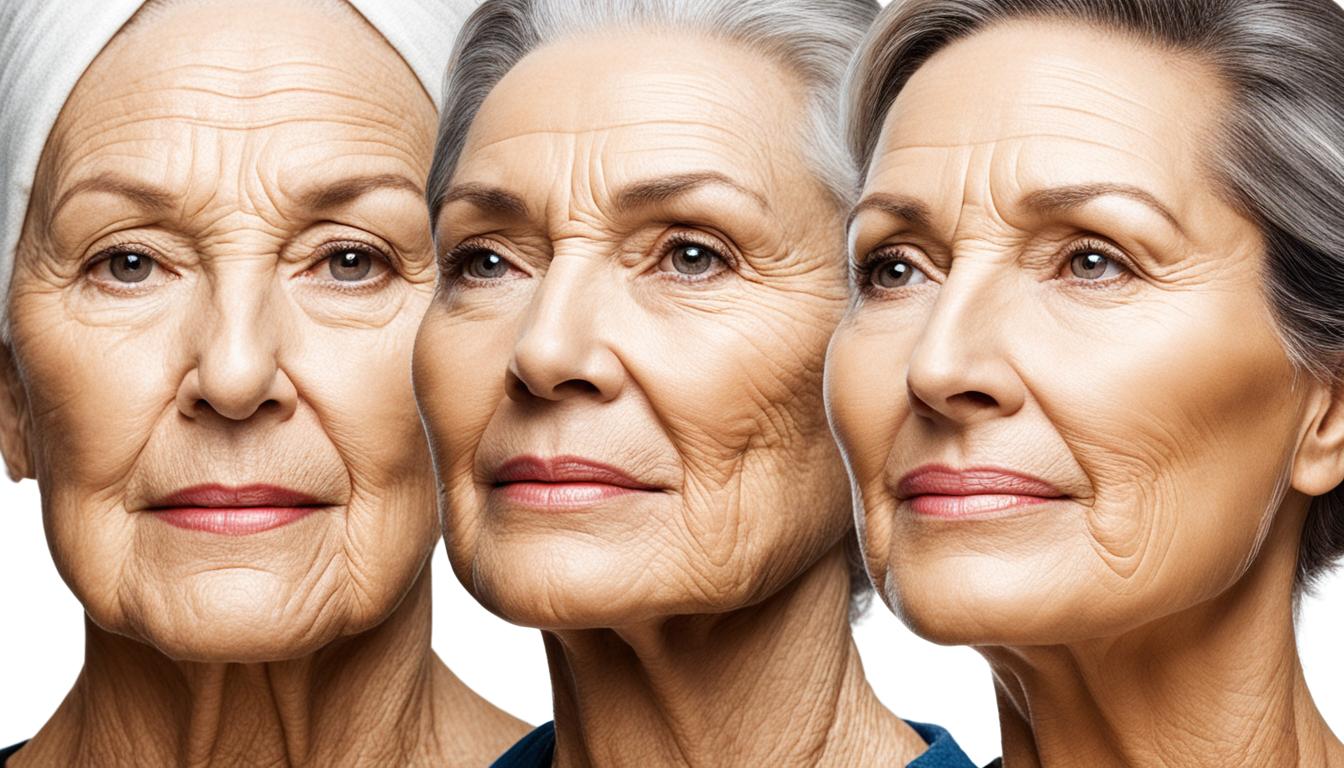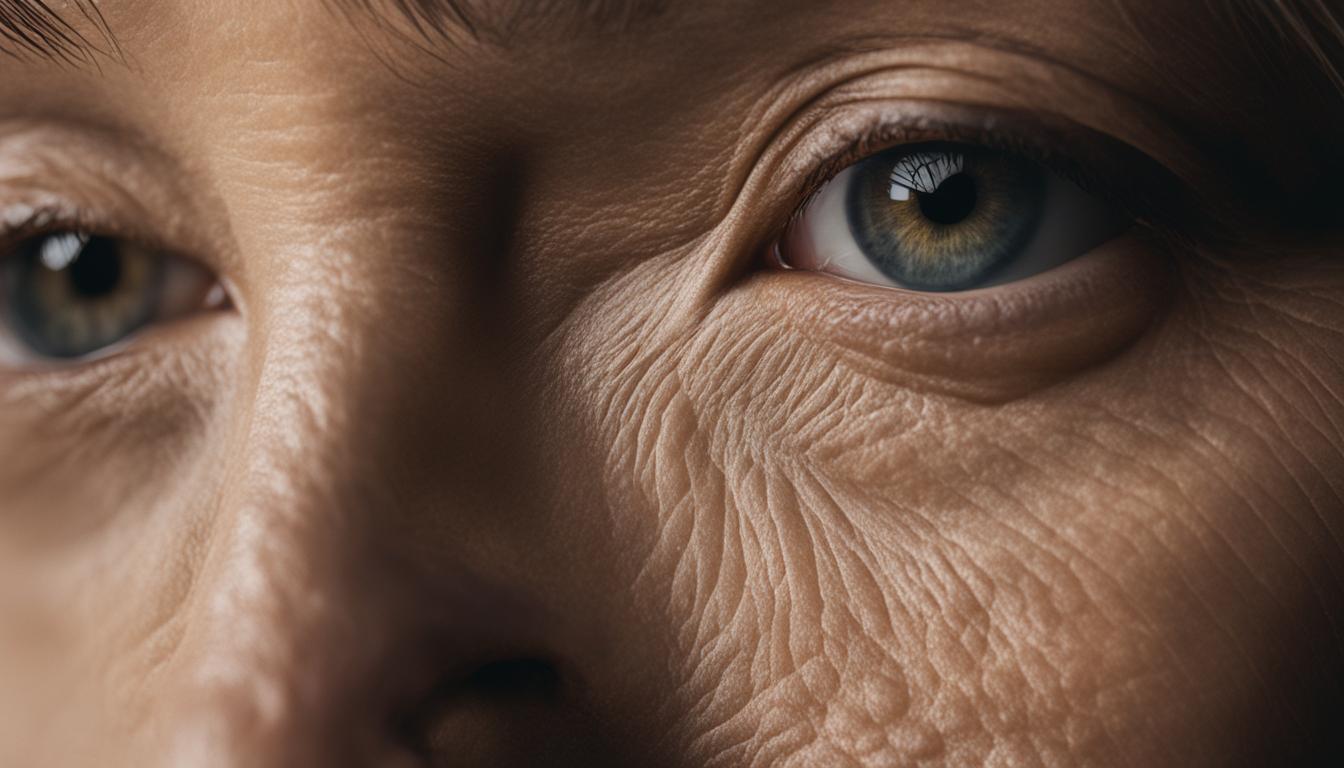As we age, our skin undergoes various changes that lead to the visible signs of aging. These signs can include wrinkles, dryness, age spots, and changes in skin texture and elasticity. It’s important to understand these signs in order to recognize them early and address them effectively.
Key Takeaways:
- The signs of aging in the skin can include wrinkles, dryness, age spots, and changes in texture and elasticity.
- Understanding these signs is essential for early recognition and effective treatment.
- Regular skin checks and a consistent skincare routine can help manage and prevent further skin damage.
- Avoiding sun exposure, adopting a healthy lifestyle, and using skincare products with beneficial ingredients can contribute to maintaining healthier and more youthful-looking skin as you age.
- Consulting with a dermatologist can provide personalized advice and treatment options for your specific skin concerns.
Common Signs of Aging
As we age, our skin undergoes various changes that result in common signs of aging. These signs can vary in severity and appearance, affecting each individual differently. Understanding these signs is key to effectively addressing and managing the aging process. Let’s take a closer look at some of the most prevalent signs of aging in the skin.
Thinning of the Skin
One of the noticeable signs of aging is the thinning of the skin. As we age, the production of collagen and elastin, which are responsible for maintaining the skin’s strength and elasticity, decreases. This leads to a thinner and more fragile skin texture, making it more susceptible to damage and wrinkles.
Fine Lines and Wrinkles
Fine lines and wrinkles are commonly associated with aging skin. Over time, the natural aging process, combined with factors such as sun exposure and repetitive facial expressions, can cause the skin to lose its ability to bounce back, resulting in the formation of lines and wrinkles.
Dryness
Aging skin tends to become drier due to a decrease in oil production. This can lead to a rough, flaky texture, making the skin appear dull and lackluster.
Age Spots
Another sign of aging is the development of age spots, also known as liver spots or sunspots. These are flat, brown areas that appear on areas of the skin that have been exposed to the sun over time.
Changes in Skin Texture
The texture of aging skin may become rougher and uneven. This can be attributed to slower cell turnover, decreased moisture retention, and the accumulation of dead skin cells on the surface.
Sagging
Sagging is a common sign of aging skin, particularly in areas such as the cheeks, jowls, and neck. As the skin loses its elasticity with age, it becomes less firm and begins to lose its youthful tautness.

Addressing the common signs of aging requires a proactive approach to skincare, including effective moisturization, sun protection, and targeted treatments. By understanding these signs, you can take steps to minimize their appearance and maintain healthier, more youthful-looking skin as you age.
Skin Changes Due to Aging
Aging is a natural process that affects our skin in various ways. As we age, our skin undergoes several changes that can alter its appearance and texture. Understanding these skin changes is essential for managing and preventing further damage.
One of the most noticeable changes is the thinning of the skin. Over time, the epidermis (outer layer of the skin) becomes thinner, which can make the skin more vulnerable to damage and injuries.
Additionally, aging leads to a loss of elasticity in the skin. The collagen and elastin fibers that provide support and firmness to the skin start to break down, resulting in sagging and wrinkles. This decrease in elasticity can also contribute to the formation of fine lines and crow’s feet.
Another common skin change is the development of age spots. These are areas of hyperpigmentation that appear as brown or dark spots on the skin, primarily caused by years of sun exposure. Age spots are more commonly seen on areas of the skin that are frequently exposed to the sun, such as the face, hands, and shoulders.
The aging process can also impact the skin’s moisture levels. As we get older, the skin tends to become drier and more fragile. This is due to a decrease in sebum production and a decline in the skin’s ability to retain moisture. Dry skin can feel rough, itchy, and dull.
To better understand the skin changes due to aging, refer to the table below:
| Skin Changes | Description |
|---|---|
| Thinning of the skin | The epidermis becomes thinner, making the skin more vulnerable |
| Loss of elasticity | Collagen and elastin fibers break down, leading to sagging and wrinkles |
| Development of age spots | Hyperpigmentation caused by sun exposure, appearing as dark spots |
| Dryness and fragility | The skin becomes drier and more prone to itchiness and dullness |
These skin changes are influenced by various factors, including genetics, lifestyle choices, and environmental exposures. While it is impossible to reverse the aging process, adopting a consistent skincare routine, protecting the skin from sun damage, staying hydrated, and maintaining a healthy lifestyle can help minimize the effects of aging on the skin.

Visible Signs of Aging on the Face
The face is particularly susceptible to signs of aging, including fine lines and wrinkles, sagging skin, age spots, and changes in skin texture. These visible signs of aging can make a person appear older and affect self-confidence. It is important to address these concerns and take proactive steps to minimize their impact. By adopting a skincare routine and practicing good skincare habits, you can help combat these signs of aging and maintain a more youthful and vibrant appearance.
One common sign of aging on the face is the development of fine lines and wrinkles. These lines typically appear around the eyes, forehead, and mouth. They are caused by a combination of factors, including a decrease in collagen production and the repetitive movements of facial muscles over time. While fine lines and wrinkles are a natural part of the aging process, they can be managed and reduced through various skincare treatments and products.
Sagging skin is another visible sign of aging on the face. As we age, the skin loses its elasticity and firmness, resulting in drooping or sagging in certain areas. This can create a tired or worn-out appearance. To help combat sagging skin, there are treatments available, such as facial exercises, non-surgical procedures like microcurrent therapy, and surgical options like facelifts. These treatments can help lift and tighten the skin, giving a more youthful and rejuvenated look.
Age spots, also known as liver spots or sunspots, are another common sign of aging on the face. These are flat, brown spots that appear on areas of the face that have been exposed to the sun over time. Age spots are caused by an increase in melanin production, resulting from sun damage. They can be prevented by consistently using sunscreen and other sun protection measures, such as wearing hats and seeking shade. There are also various treatments available to fade or remove age spots, including topical creams, laser therapy, and chemical peels.
Changes in skin texture are also noticeable signs of aging on the face. These changes can include roughness, uneven skin tone, and a loss of smoothness. Factors such as sun exposure, environmental pollutants, and natural aging can contribute to these texture changes. To improve skin texture, exfoliating regularly, using moisturizers and serums with ingredients like hyaluronic acid and retinol, and seeking professional treatments like microdermabrasion or chemical peels can be helpful.

In conclusion, the face is highly susceptible to visible signs of aging, including fine lines and wrinkles, sagging skin, age spots, and changes in skin texture. However, with proper skincare and targeted treatments, these signs can be minimized and managed. It’s important to establish a regular skincare routine and consult with skincare professionals to find the most suitable treatments for your individual concerns. By addressing these signs of aging, you can maintain a youthful and confident appearance throughout the aging process.
Skin Cancer and Aging
Aging skin is more susceptible to skin cancer. The cumulative effects of sun exposure over the years can increase the risk of developing skin cancer. Regularly checking the skin for any changes, such as new growths, moles that change in size or color, or sores that don’t heal, is important for early detection and treatment of skin cancer.
Early detection is crucial in improving the prognosis of skin cancer. By being vigilant and aware of the signs of skin cancer, you can seek medical attention promptly, increasing the chances of successful treatment. Here are some common signs of skin cancer to watch out for:
- Changes in the color, size, or shape of existing moles or birthmarks
- New growths or sores that don’t heal within a few weeks
- Bleeding, itching, or crusting of skin lesions
- Spots or patches that are different from the rest of the skin
If you notice any of these signs, it is important to consult a dermatologist for a thorough examination. Remember, early detection and treatment can significantly improve outcomes and prevent the spread of skin cancer.
“Regularly checking your skin for any changes is essential for the early detection of skin cancer.”

| Type of Skin Cancer | Description |
|---|---|
| Basal Cell Carcinoma | The most common type of skin cancer. It often appears as a pink or flesh-colored bump that may bleed or develop a crust. |
| Squamous Cell Carcinoma | The second most common type of skin cancer. It usually appears as a scaly red patch or a raised growth with a central depression. |
| Melanoma | The most dangerous form of skin cancer. It can develop from existing moles or appear as a new dark spot with irregular borders and various colors. |
Factors Contributing to Aging Skin
Several factors play a role in the aging of our skin. Understanding these factors can help us take proactive measures to maintain healthier and more youthful-looking skin as we age.
Sun Exposure
One of the primary causes of aging skin is prolonged exposure to the sun’s harmful UV rays. Over time, these rays can damage the skin’s collagen and elastin fibers, leading to wrinkles, fine lines, and age spots.
Genetics
Our genetic makeup also contributes to how our skin ages. Some individuals may inherit genes that make them more prone to experiencing premature aging, while others may have genes that support a more youthful complexion.
Lifestyle Choices
The lifestyle choices we make can have a significant impact on our skin’s aging process. Smoking, for example, is known to accelerate skin aging by constricting blood vessels, reducing oxygen flow, and damaging collagen and elastin fibers. On the other hand, adopting a healthy lifestyle that includes regular exercise, a balanced diet, and proper hydration can help promote healthier skin.
Environmental Factors
Environmental factors such as pollution, harsh weather conditions, and exposure to toxins can contribute to aging skin. These factors can deplete the skin’s natural defenses, leading to inflammation, oxidative stress, and accelerated aging.
| Factors Contributing to Aging Skin | Description |
|---|---|
| Sun Exposure | Prolonged exposure to UV rays damages collagen and elastin, causing wrinkles and age spots. |
| Genetics | Individual genetic makeup influences how the skin ages. |
| Lifestyle Choices | Smoking and unhealthy habits accelerate skin aging, while a healthy lifestyle promotes skin health. |
| Environmental Factors | Pollution, harsh weather, and exposure to toxins contribute to skin inflammation and oxidative stress. |
By recognizing these factors and taking appropriate steps to counteract their effects, we can improve the overall health and appearance of our skin as we age.
Maintaining Healthy Skin as You Age
As you age, it becomes essential to prioritize the health and appearance of your skin. By adopting a daily skincare routine and making conscious lifestyle choices, you can maintain healthy and radiant skin. Here are some key practices to include in your skincare routine for aging skin:
- Cleansing: Cleanse your skin twice a day to remove impurities, dirt, and excess oil. Use a gentle cleanser that is suitable for your skin type to avoid stripping away natural oils.
- Moisturizing: Keeping your skin hydrated is crucial for maintaining its health and reducing the appearance of fine lines and wrinkles. Choose a moisturizer that contains ingredients like hyaluronic acid or ceramides to lock in moisture.
- Sun Protection: Protecting your skin from the harmful effects of the sun is vital for minimizing skin damage and maintaining a youthful appearance. Apply a broad-spectrum sunscreen with an SPF of 30 or higher every day, even during cloudy days.
- Healthy Diet: A well-balanced diet is key to maintaining healthy skin. Incorporate foods rich in antioxidants, vitamins, and minerals, such as fruits, vegetables, whole grains, and lean proteins.
- Hydration: Drink an adequate amount of water throughout the day to keep your skin hydrated from within. Proper hydration helps in maintaining the skin’s elasticity and overall health.
- Avoid Smoking: Smoking accelerates the aging process and damages collagen and elastin fibers in the skin. Quitting smoking or avoiding exposure to secondhand smoke can help preserve the health and appearance of your skin.
- Moderate Alcohol Consumption: Excessive alcohol consumption can dehydrate the skin and lead to inflammation. Limit your alcohol intake to maintain the health and vitality of your skin.
Remember, maintaining healthy skin as you age is a holistic approach that involves consistent skincare practices, a healthy lifestyle, and protection from external factors. By following these guidelines, you can promote the longevity and natural beauty of your skin.
| Skincare Routine for Aging Skin | Description |
|---|---|
| Cleansing | Remove impurities and dirt with a gentle cleanser suitable for your skin type. |
| Moisturizing | Hydrate your skin and reduce the appearance of fine lines and wrinkles with a moisturizer containing nourishing ingredients. |
| Sun Protection | Shield your skin from harmful UV rays by applying a broad-spectrum sunscreen with an SPF of 30 or higher. |
| Healthy Diet | Nourish your skin from the inside out by consuming a balanced diet rich in antioxidants, vitamins, and minerals. |
| Hydration | Keep your skin hydrated by drinking an adequate amount of water throughout the day. |
| Avoid Smoking | Quit smoking or avoid exposure to secondhand smoke to prevent premature aging of the skin. |
| Moderate Alcohol Consumption | Limit your alcohol intake to maintain the health and vitality of your skin. |
Prevention and Treatment of Aging Skin
While some signs of aging are inevitable, there are steps you can take to minimize their appearance. Prevention measures and effective treatment options can help you maintain healthier and more youthful-looking skin as you age.
Prevention of Aging Skin
Preventing the signs of aging starts with protecting your skin from harmful sun exposure. UV rays can accelerate the aging process and lead to wrinkles, age spots, and other skin damage. Remember to:
- Apply broad-spectrum sunscreen with at least SPF 30 every day, even on cloudy days.
- Wear protective clothing, such as wide-brimmed hats and sunglasses, when exposed to the sun.
- Seek shade and avoid direct sunlight during peak hours.
In addition to sun protection, using skincare products with ingredients that promote skin health can help minimize signs of aging. Look for products that contain antioxidants, such as vitamin C and green tea extract, which can help protect against free radical damage.
Avoiding harmful habits can also contribute to the prevention of aging skin. Smoking has been linked to premature aging and wrinkles, so quitting smoking can help improve the overall health and appearance of your skin.
Treatment for Aging Skin
If signs of aging have already appeared, there are various treatment options available to address them:
| Treatment Option | Description |
|---|---|
| Cosmetic Procedures | Cosmetic procedures, such as Botox injections, dermal fillers, and chemical peels, can help reduce the appearance of wrinkles, fine lines, and sagging skin. |
| Skincare Treatments | Skincare treatments, including laser resurfacing, microdermabrasion, and photofacials, can improve skin texture, tone, and firmness. |
| Lifestyle Modifications | Adopting a healthy lifestyle can make a significant difference in aging skin. Eating a nutritious diet, staying hydrated, getting regular exercise, and managing stress levels all contribute to overall skin health. |
Consulting with a dermatologist is essential to determine the most suitable treatment options for your specific skin concerns. They can provide personalized recommendations and guidance based on your skin type and desired outcomes.
Conclusion
In conclusion, aging affects our skin in various ways, resulting in visible signs of aging such as wrinkles, dryness, age spots, and changes in texture and elasticity. However, by understanding these signs and taking preventive measures, we can maintain healthier and more youthful-looking skin as we age.
It is crucial to consult with a dermatologist for personalized advice and treatment options that cater to your specific skin concerns. They can provide professional guidance on effective skincare routines, recommend suitable products, and suggest treatments or procedures that can minimize the appearance of aging signs.
Remember, the key to maintaining healthy skin as you age is to establish a consistent skincare routine that includes cleansing, moisturizing, and protecting your skin from sun exposure. Additionally, making healthy lifestyle choices such as following a balanced diet, staying hydrated, and avoiding smoking can significantly contribute to your overall skin health.
By prioritizing the health of our skin and implementing the recommended preventive measures, we can embrace the aging process with confidence and grace, knowing that we are taking the necessary steps to support our skin’s well-being.
FAQ
What are the common signs of aging in the skin?
The common signs of aging in the skin include wrinkles, dryness, age spots, changes in skin texture, and sagging.
How does aging affect the skin?
Aging leads to thinner skin, loss of fat, fine lines and wrinkles, dryness, age spots, changes in skin texture, and sagging.
What are the visible signs of aging on the face?
The visible signs of aging on the face include fine lines and wrinkles, sagging skin, age spots, and changes in skin texture.
Can aging skin be more susceptible to skin cancer?
Yes, aging skin is more susceptible to skin cancer due to the cumulative effects of sun exposure over the years.
What factors contribute to aging skin?
Factors such as sun exposure, genetics, lifestyle choices (such as smoking), and environmental factors contribute to aging skin.
How can I maintain healthy skin as I age?
You can maintain healthy skin as you age by adopting a daily skincare routine, eating a healthy diet, staying hydrated, and avoiding harmful habits such as smoking and excessive alcohol consumption
Are there preventive measures for minimizing signs of aging?
Yes, preventive measures for minimizing signs of aging include protecting your skin from sun exposure, using skincare products with beneficial ingredients, and avoiding harmful habits such as smoking.
What are the treatment options for aging skin?
Treatment options for aging skin include cosmetic procedures, skincare treatments, and lifestyle modifications.
How can I address the signs of aging in my skin?
To address the signs of aging in your skin, it is recommended to consult with a dermatologist for personalized advice and treatment options.


